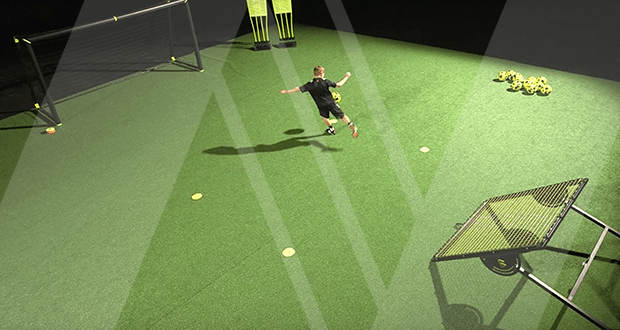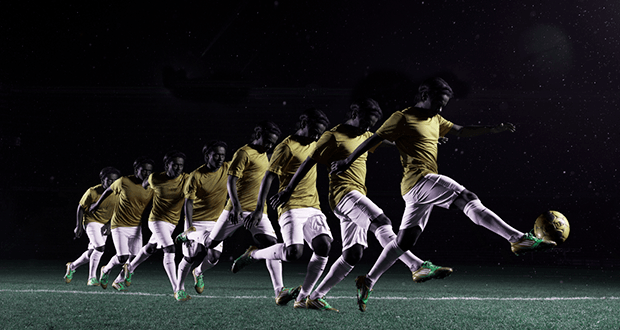A great offense wins games, but a strong defense wins championships. Conceding goals is just as impactful as scoring them, so if you have trouble scoring goals, it is imperative that you do not concede any. For young players, choosing to be a defender may not be as appealing as choosing to be a striker, because those who score goals are the ones most often acknowledged.
However, defenders are just as important as strikers, and being a defender requires even more concentration because every mistake can be especially detrimental to the success of the team. Fans forget the moment a striker misses an open goal, but they remember poor defending because it leads directly to goals.
Take your defending to the next level with these 5 drills for the m-station soccer rebounder and sign up for NEXT11. Sign up here to unlock new drills on a weekly basis and continuously improve your defending.
1. Headers — Clearing
Being able to clear the ball correctly with a header, especially if you are a center-back, is crucial. First of all, if you mistime your header and only graze the ball with the top of your head, the botched clearance is just as dangerous as the cross itself, and perhaps even more so as there is one less defender to take care of the ball. Secondly, by clearing correctly with a header, you are asserting dominance and the opposing team will be less inclined to try crosses again. This is a way of protecting the keeper, as many goalkeepers prefer shot stopping to dealing with aerial balls.
When performing this drill with the m-station soccer rebounder, make sure to keep your eyes on the ball and take a slightly offset stance before you jump.
2. Short passes — Interceptions and passing on the first touch
For a modern center-back, soccer is not just about tackling, heading, and marking. You need to be able to participate in the game even more; having a center-back with great skill on the ball allows greater options for a team during a game. Also, if you can pass both long and short, you reduce your limitations as a player. If the opposing team emphasizes marking your forwards, pass it short. If the opposing team pushes your defensive midfielders or your defenders up, pass it long.
To improve short passing, make sure to look up when you know where you will meet the ball to see where your opponents are. Next, lock your angle and kick the ball with the inside of your foot. For every move you make on the field, it is important to look up in order to give yourself an overview of the field and players’ positions. Do not make assumptions or pass blindly — learn how to look up while playing.
3. Crosses — Shoulder feint and crossing
Defense is not solely about center-backs; fullbacks are just as important, but not only for defensive reasons. In today’s soccer, it is important to be able to contribute on both ends of the field by dribbling, overlapping, and crossing. Coaches do not want a Gary Neville anymore; they want a Jordi Alba, a Marcelo, or a Dani Alves. Looking at Barcelona, the runs from Dani Alves and Jordi Alba are instrumental parts of the offense, as the players offer width and depth on their respective sides of the field. When Messi has the ball, Alba makes the deep run, and when Neymar has the ball, Dani Alves makes the deep run.
When crossing, as exemplified in this drill, approach the ball at a 45-60 degree angle, raise your arms to the side, and strike the ball with the inside of your foot.
4. Dribbling — Dribbling straight
As a fullback, you will have to create space for your teammates by almost always going wide. By staying wide, regardless of whether you are in possession of the ball or not, you demand attention and therefore stretch the defensive line of the opposing team, which ultimately provides space for your team’s more creative players to operate in. However, if you too are capable of dribbling, you demand even more attention, as the defender cannot stay 1v1 against you. Naturally, if you drag two players towards you, at least one of your teammates will have enough space to do something. As a fullback, you should stay wide in order to not take up space that is already occupied, which is why dribbling straight is important.
Point your toes towards the ground as if to strike the ball using your laces, and make small touches using the laces with the ball in front of you. Frequent small touches give you better control as you run.
5. Long passes — Switching the play
As mentioned earlier, a center-back’s participation in the build-up of a play is essential to a team’s success in many tactical systems. Most teams prefer to build up gradually from the defense rather than send long balls for tall strikers, as most strikers at top-level play are all about movement off the ball, first touches, and finishing. However, on occasion you might want to play a long ball to the wing or the forward, and as a center-back, you have to be prepared for this. Stay clear of a marking and run into a position where you can receive the ball to take pressure off your teammates. Playing a long ball does not necessarily have to be an act of panic.
Before you receive the ball, look up to understand the movement on the field. Approach the ball at a 45-degree angle, lean your body a bit away from the ball to create a straight line from your foot up through your hip and shoulder, place your standing foot 10-20 cm away from the ball (depending on your height), and point it in the direction of the pass.
If you have any questions about the m-station soccer rebounder or these drills, please do not hesitate to get directly in touch with our coaches at coach@muninsports.com.



